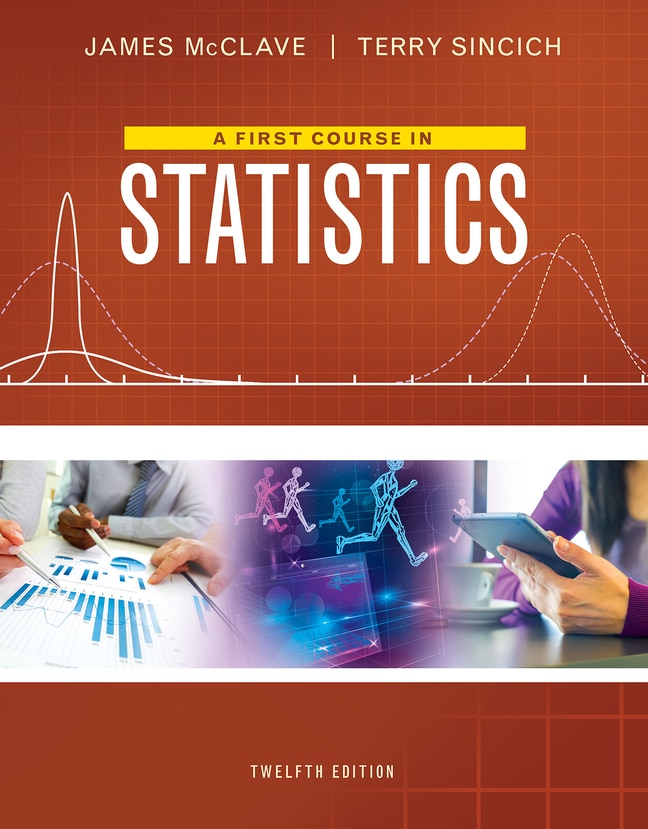
First Course in Statistics, A, 12th edition
- James T McClave
- , Terry T Sincich

- Watch and learn
Videos & animations bring concepts to life
- Find it fast
Quickly navigate your eTextbook with search
- Stay organized
Access all your eTextbooks in one place
- Easily continue access
Keep learning with auto-renew
A First Course in Statistics is a trusted, comprehensive introduction that emphasizes inference and integrates real data throughout. The authors emphasize development of statistical thinking, assessment of credibility, and value of the inferences made from data. Flexibility is built in for more advanced versions of the course, with optional footnotes about calculus and the underlying theory. A background of basic algebra is assumed.
The 12th Edition is extensively revised with an eye on clearer, more concise language throughout the text and in the exercises.
Published by Pearson (December 11th 2020) - Copyright © 2017
ISBN-13: 9780137400058
Subject: Introductory Statistics
Category:
Table of Contents
- Statistics, Data, and Statistical Thinking
- 1.1 The Science of Statistics
- 1.2 Types of Statistical Applications
- 1.3 Fundamental Elements of Statistics
- 1.4 Types of Data
- 1.5 Collecting Data: Sampling and Related Issues
- 1.6 The Role of Statistics in Critical Thinking and Ethics
- Statistics in Action: Social Media Network Usage-Are You Linked In?
- Using Technology: MINITAB: Accessing and Listing Data
- Methods for Describing Sets of Data
- 2.1 Describing Qualitative Data
- 2.2 Graphical Methods for Describing Quantitative Data
- 2.3 Numerical Measures of Central Tendency
- 2.4 Numerical Measures of Variability
- 2.5 Using the Mean and Standard Deviation to Describe Data
- 2.6 Numerical Measures of Relative Standing
- 2.7 Methods for Detecting Outliers: Box Plots and z-Scores
- 2.8 Graphing Bivariate Relationships (Optional)
- 2.9 Distorting the Truth with Descriptive Statistics
- Statistics in Action: Body Image Dissatisfaction: Real or Imagined?
- Using Technology: MINITAB: Describing Data
- TI-83/TI—84 Plus Graphing Calculator: Describing Data
- Probability
- 3.1 Events, Sample Spaces, and Probability
- 3.2 Unions and Intersections
- 3.3 Complementary Events
- 3.4 The Additive Rule and Mutually Exclusive Events
- 3.5 Conditional Probability
- 3.6 The Multiplicative Rule and Independent Events
- Statistics in Action: Lotto Buster! Can You Improve Your Chance of Winning?
- Using Technology: TI-83/TI-84 Plus Graphing Calculator: Combinations and Permutations
- Random Variables and Probability Distributions
- 4.1 Two Types of Random Variables
- 4.2 Probability Distributions for Discrete Random Variables
- 4.3 The Binomial Random Variable
- 4.4 Probability Distributions for Continuous Random Variables
- 4.5 The Normal Distribution
- 4.6 Descriptive Methods for Assessing Normality
- 4.7 Approximating a Binomial Distribution with a Normal Distribution (Optional)
- 4.8 Sampling Distributions
- 4.9 The Sampling Distribution of x and the Central Limit Theorem
- Statistics in Action: Super Weapons Development — Is the Hit Ratio Optimized?
- Using Technology: MINITAB: Discrete Probabilities
- Inferences Based on a Single Sample
- 5.1 Identifying and Estimating the Target Parameter
- 5.2 Confidence Interval for a Population Mean: Normal (z) Statistic
- 5.3 Confidence Interval for a Population Mean: Student’s t-Statistic
- 5.4 Large-Sample Confidence Interval for a Population Proportion
- 5.5 Determining the Sample Size
- 5.6 Confidence Interval for a Population Variance (Optional)
- Statistics in Action: Medicare Fraud Investigations
- Using Technology: MINITAB: Confidence Intervals
- Inferences Based on a Single Sample
- 6.1 The Elements of a Test of Hypothesis
- 6.2 Formulating Hypotheses and Setting Up the Rejection Region
- 6.3 Observed Significance Levels: p-values
- 6.4 Test of Hypothesis about a Population Mean: Normal (z) Statistic
- 6.5 Test of Hypothesis about a Population Mean: Student’s t-Statistic
- 6.6 Large-Sample Test of Hypothesis about a Population Proportion
- 6.7 Test of Hypothesis about a Population Variance (Optional)
- 6.8 A Nonparametric Test about a Population Median (Optional)
- Statistics in Action: Diary of a KLEENEX User How Many Tissues in a Box?
- Using Technology: MINITAB: Tests of Hypotheses
- TI-83/TI-84 Plus Graphing Calculator: Tests of Hypotheses
- Comparing Population Means
- 7.1 Identifying the Target Parameter
- 7.2 Comparing Two Population Means: Independent Sampling
- 7.3 Comparing Two Population Means: Paired Difference Experiments
- 7.4 Determining the Sample Size
- 7.5 A Nonparametric Test for Comparing Two Populations: Independent Samples
- 7.6 A Nonparametric Test for Comparing Two Populations: Paired Difference Experiment (Optional)
- 7.7 Comparing Three or More Population Means: Analysis of Variance (Optional)
- Statistics in Action: Zixlt Corp. vs. Visa USA Inc. — A Libel Case
- Using Technology: MINITAB: Comparing Means
- TI-83/TI-84 Plus Graphing Calculator: Comparing Means
- Comparing Population Proportions
- 8.1 Comparing Two Population Proportions: Independent Sampling
- 8.2 Determining Sample Size
- 8.3 Testing Category Probabilities: Multinomial Experiment
- 8.4 Testing Categorical Probabilities: Two-Way (Contingency) Table
- Simple Linear Regression
- 9.1 Probabilistic Models
- 9.2 Fitting the Model: The Least Squares Approach
- 9.3 Model Assumptions
- 9.4 Assessing the Utility of the Model: Making Inferences about the Slope β1
- 9.5 The Coefficients of Correlation and Determination
- 9.6 Using the Model for Estimation and Prediction
- 9.7 A Complete Example
- 9.8 A Nonparametric Test for Correlation (Optional)
- Statistics in Action: Can “Dowsers” Really Detect Water?
- Using Technology: MINITAB: Simple Linear Regression
- TI-83/TI-84 Plus Graphing Calculator: Simple Linear Regression